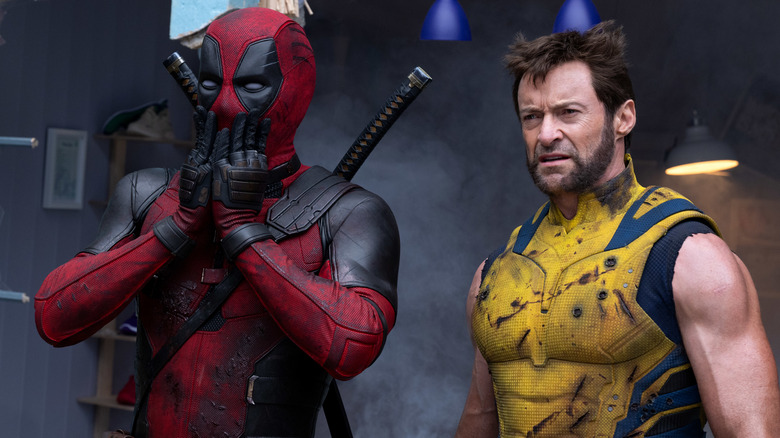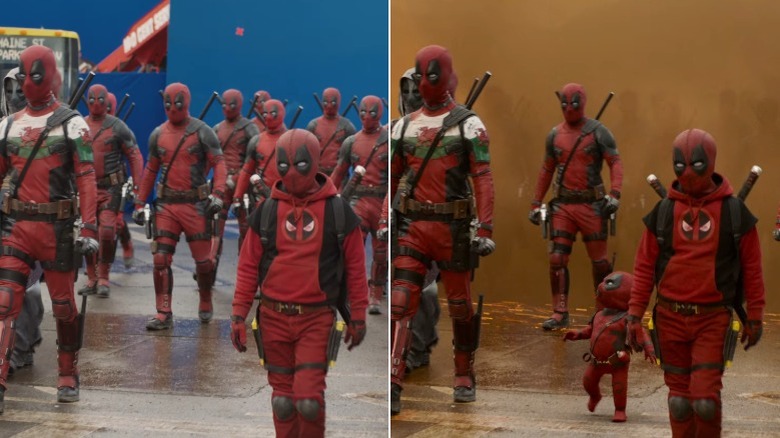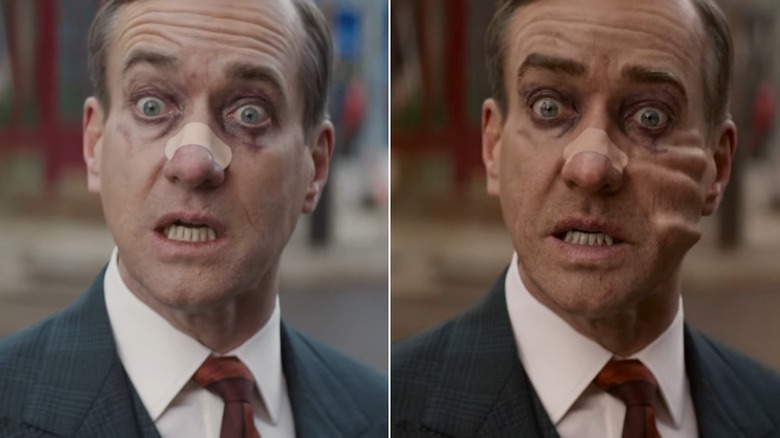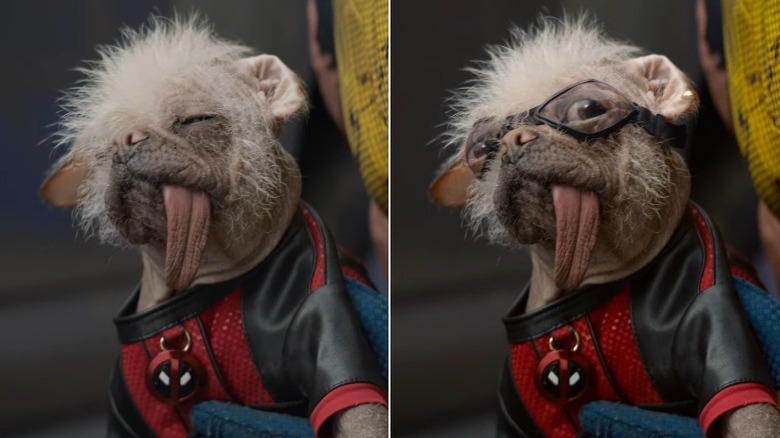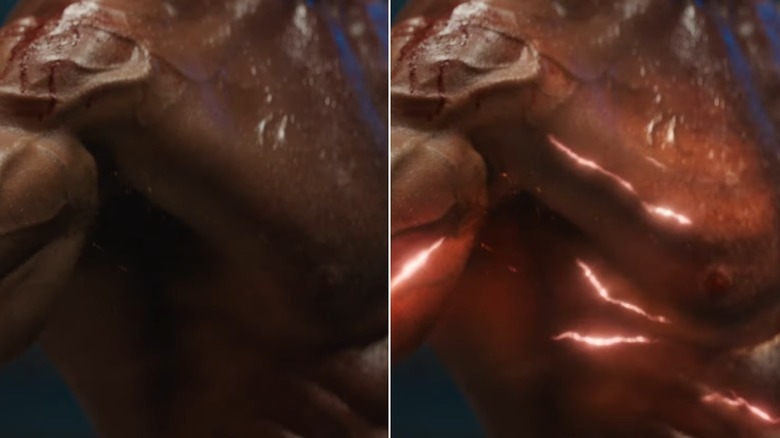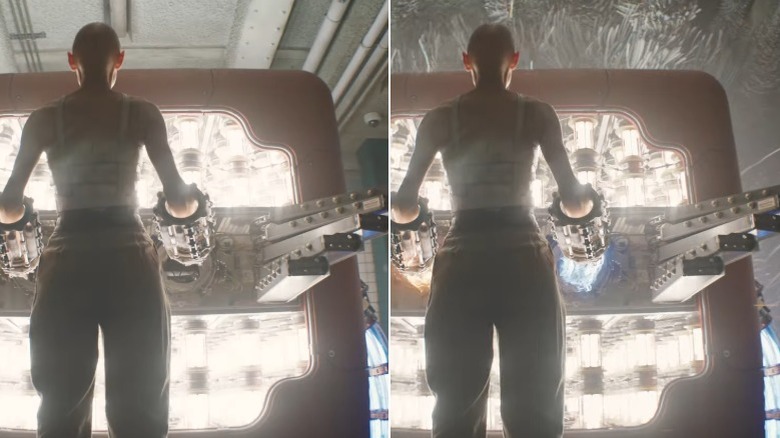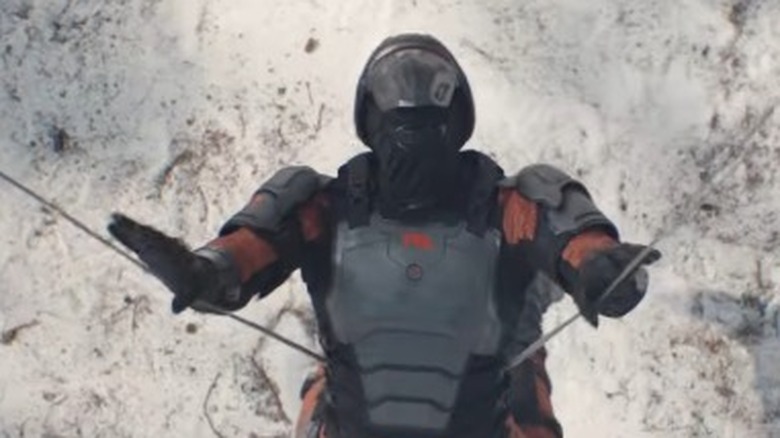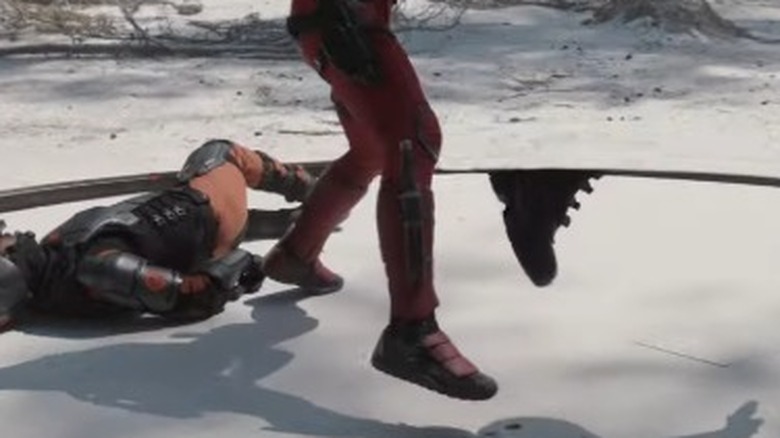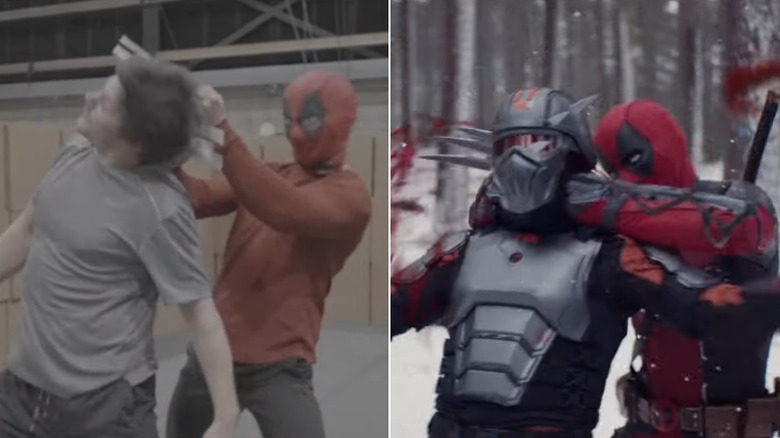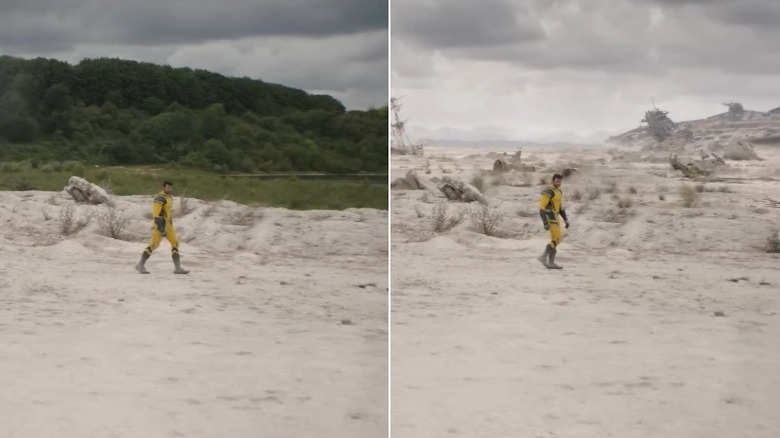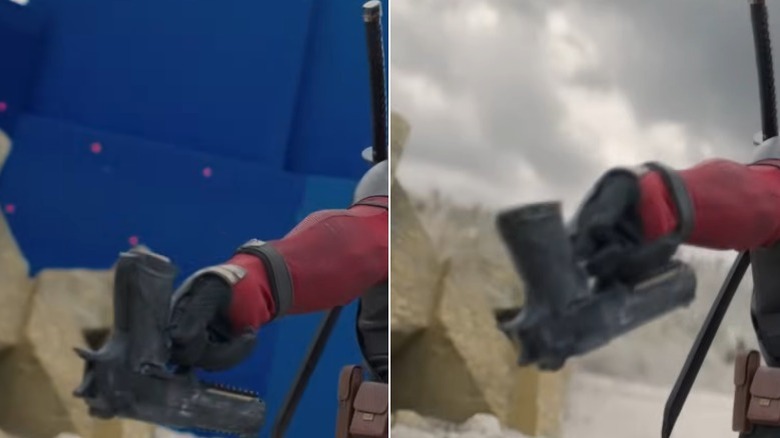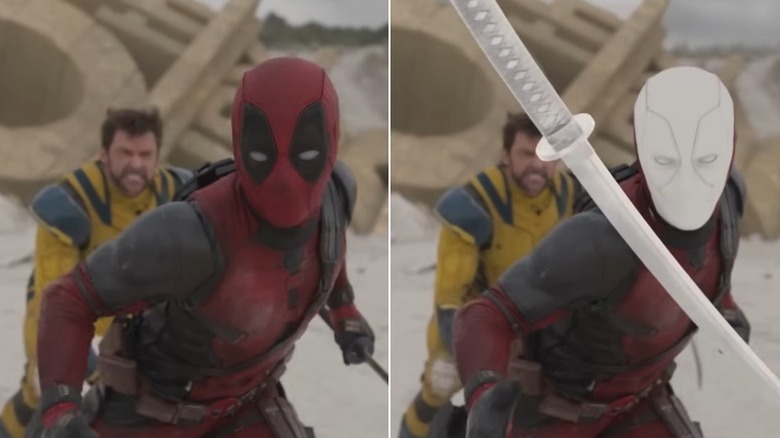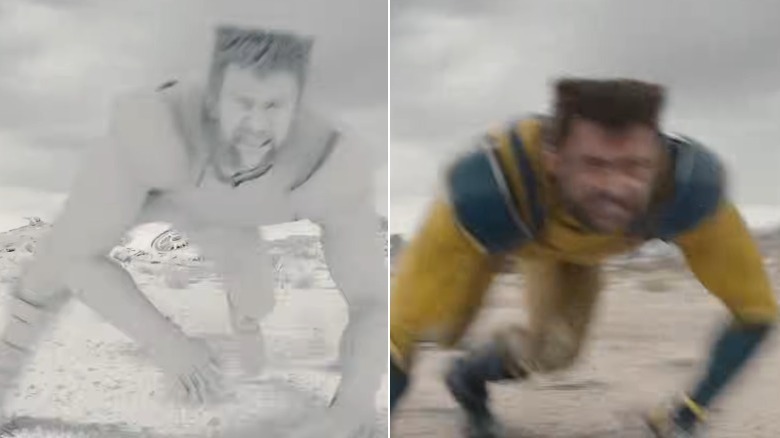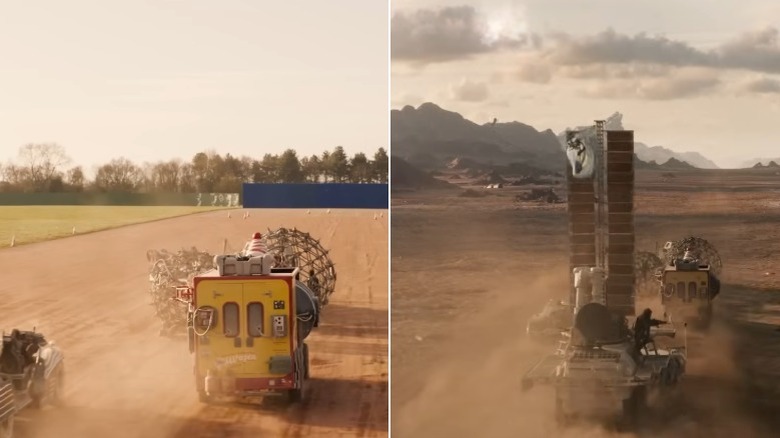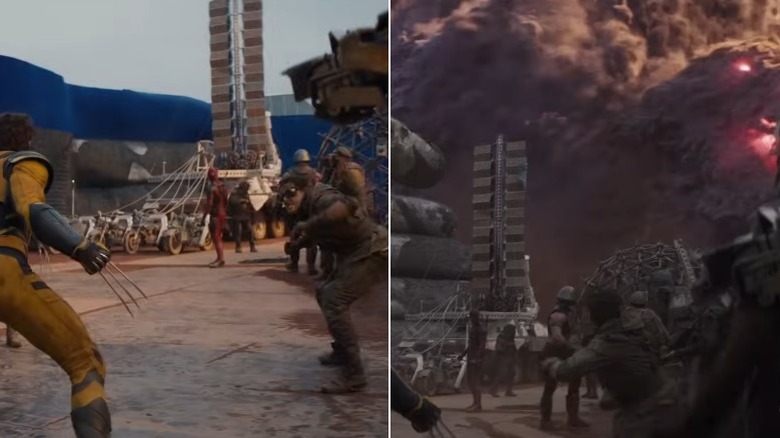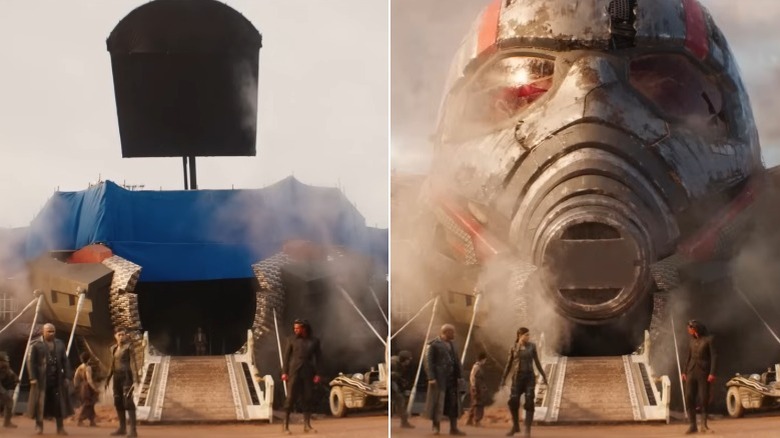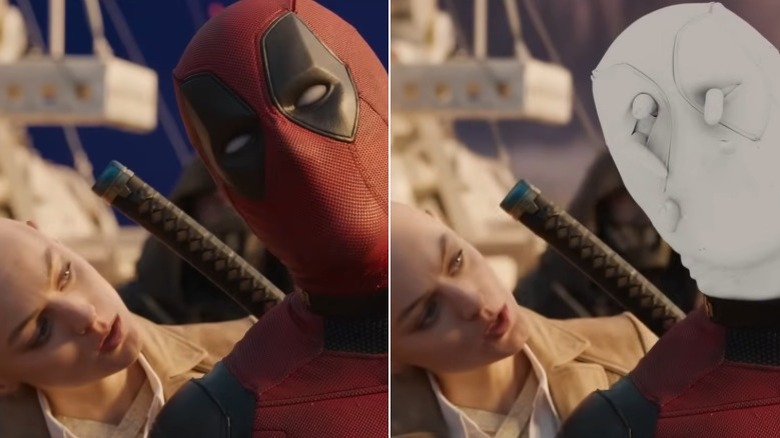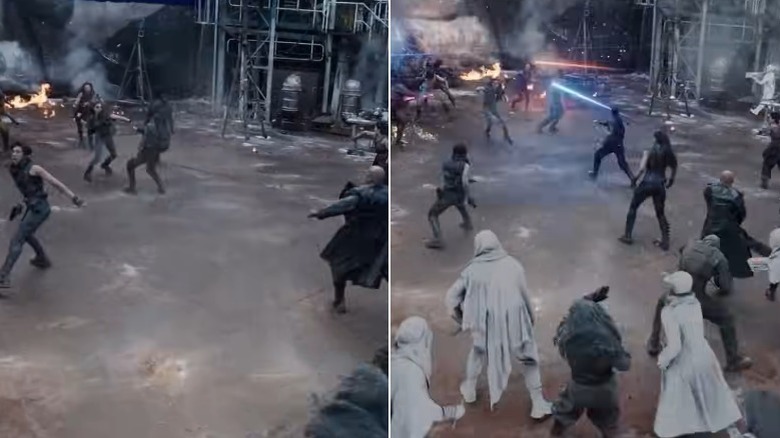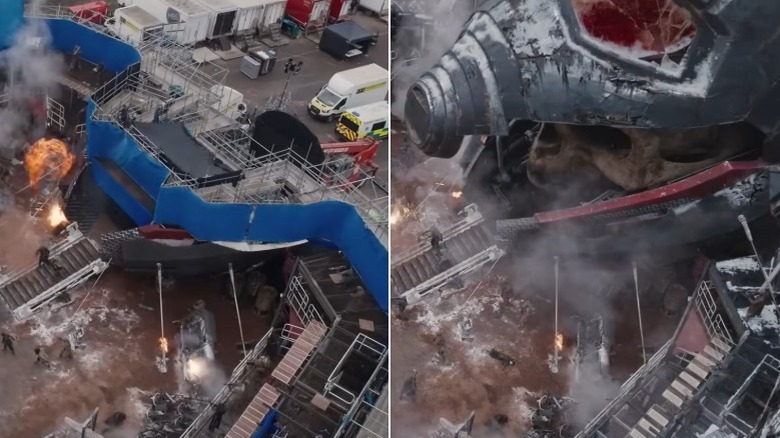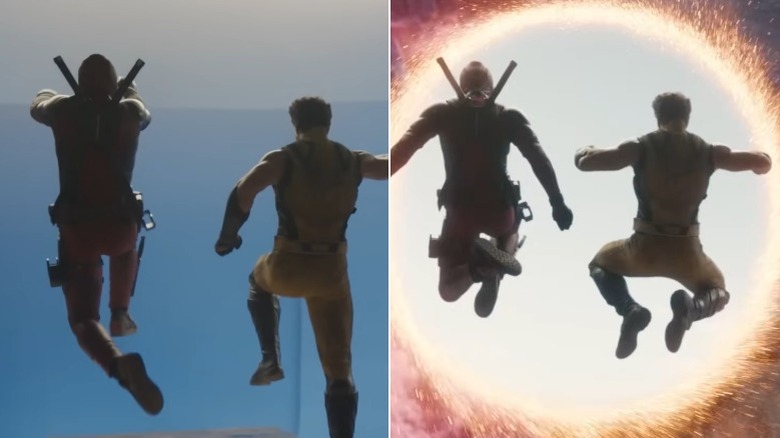What Deadpool And Wolverine Looks Like Without Special Effects
Each entry in the "Deadpool" series has one-upped the previous film in terms of production value. Where the first "Deadpool" movie got made as a scrappy, mid-sized action flick that worked wonders with a relatively modest $58 million budget, the second one upped the ante with a $110 million price tag and bigger, busier, more star-studded and cameo-filled action sequences.
Then in 2024, we had "Deadpool & Wolverine," which ushered the Merc into the MCU with due pomp and circumstance — and, by pomp and circumstance, we mean a staggering $200 million production budget. It would have been an event film just from putting Wade Wilson (Ryan Reynolds) and Logan (Hugh Jackman) together, but, on a visual level, "Deadpool & Wolverine" also looks absolutely massive, with some of the finest, most complex CGI work in the franchise so far. To give you an idea of just how much work went into bringing this movie to screen, here are a few glimpses at what "Deadpool & Wolverine" looks like without special effects.
The army of Deadpools was real except for Baby Deadpool
In the scene that sees Cassandra Nova (Emma Corrin) summon an army of Deadpool variants to fight Deadpool and Wolverine, you might have assumed — given the sheer number of Deadpools on screen (though some Deadpool variants still got left out!) — that at least some of them were created via CGI. But, as it turns out, the crowd was (almost) entirely real.
As revealed in a behind-the-scenes VFX demo reel released by Framestore, there really were dozens of performers in Deadpool suits walking together in that scene, including such striking variants as Welsh Deadpool and Golden Age Deadpool. Only one variant was a CGI creation as opposed to a live actor: Naturally, Baby Deadpool. Otherwise, the only CGI additions to the scene were the city background (save for a handful of practical scenery elements like a parked bus) and the portal through which the variants emerge.
Matthew Macfadyen had to pretend a hand was phasing through his face
Matthew Macfadyen is no stranger to portraying discomfort and despair — it's part of what earned him so much acclaim in roles like Mr. Darcy in "Pride & Prejudice" and Tom Wambsgans in "Succession." His ability to effortlessly project that kind of sustained anxiety made him a great fit to play Mr. Paradox in "Deadpool & Wolverine." But in addition to playing to his strengths, the movie also made very unique demands of him as an actor.
Specifically, in the scene where Cassandra Nova phases her hand through Paradox's head, the Framestore reel reveals that the shot was accomplished by filming Macfadyen normally and then layering the effect on top of him via CGI. Therefore, Macfadyen had to act as though his face were being invaded by a hand — which must have been a pretty challenging emotion to get across convincingly, even for a two-time Emmy-winning actor.
Dogpool's performance was augmented through CGI goggles
Mary Puppins a.k.a. Dogpool was famously played by Peggy, the Pugese dog who was crowned Britain's Ugliest Dog in 2023 and then turned her infamy around by becoming a global superstar. Some more physically demanding shots of Dogpool were accomplished by filming Peggy as a reference and then animating a CGI model in accordance with her movement, while others featured Peggy in the flesh.
Even for some of the shots featuring the real Peggy, however, the VFX artists augmented her performance by giving Dogpool goggles, as revealed by the Framestore reel. Within the goggles' lenses, Dogpool's eyes were widened and animated with CGI, allowing the filmmakers to avail themselves of Peggy's tour-de-force physicality while having more control over the directions in which Dogpool was looking at any given moment.
Hugh Jackman's body was really that chiseled
It is not unheard of for films to give actors some extra pounds of muscle via CGI, and, given that Hugh Jackman's body in "Deadpool & Wolverine" is so lean and muscular as to give off the appearance of having been sculpted by a Renaissance artist, you might have wondered if it really looked like that in real life. As a matter of fact, it did.
The Framestore reel shows that, in the shot where Wade and Logan absorb the power of the chambers of matter and anti-matter, the only CGI additions were the flow of red-hot energy coursing through Logan's body and the rifts being opened on his skin. The muscles themselves, including the dilated veins on Jackman's arm, were, well, practical. Granted, even without any CGI involved, one could argue Hollywood muscle-building regimens like the one Jackman underwent to get ripped for "Deadpool & Wolverine" are their own kind of special effect.
The Time Ripper was a practical set
The Time Ripper — i.e., the cubic device with timeline-destroying capabilities owned by the Time Variance Authority and eventually hijacked by Cassandra Nova — is one of the most impressive pieces of production design in "Deadpool & Wolverine." Its edgeless cubic shape, the dense batch of wires and Reset Charges of which it's made up, and the surreal mass of energy it produces in the subway station all combine to form the kind of mind-boggling visual that blockbusters are made to deliver.
Even more impressively, it was a practical set. While the mass of energy behind it was naturally CGI, the Time Ripper itself was — per the Framestore reel — an actual glowing white cube full of glass and metal parts, which Emma Corrin physically interacted with in Nova's climatic scene. Let that serve as yet another testament to the insuperable power (no pun intended) of practical effects.
The fight scenes involved a lot of rigging
If there's one technical aspect that the "Deadpool" franchise has become known for, it's the incredibly elaborate and energetic stunt work. The craftsmanship of the stunt team is once again on display in "Deadpool & Wolverine," which offers up some of the most brutal and balletic sequences in the series so far. But what you may not realize is that some measure of CGI work was involved in pulling off some of the stunts — namely, by hiding the rigs.
As the Framestore reel shows, in Deadpool's opening fight against the various Time Variance Authority agents attempting to arrest him, one stunt performer's movement of being intensely vaulted backwards and falling on his back was accomplished via rigging. He was literally pulled upward and backward, and the VFX team proceeded to hide the cables. Talk about interdepartmental teamwork.
The forest fight was seemingly shot on a soundstage
Another interesting tidbit about the opening forest fight is that not all of it was shot on location. Although — in a rare and amusing case of another country standing in for Vancouver, Canada, instead of the other way around — the production did hop over to Black Park in Buckinghamshire, U.K. to shoot some of the forest sequence, the Framestore reel reveals that at least one shot was filmed in a soundstage.
Namely, it's the shot in which the camera spins around Deadpool as he takes on numerous TVA agents at once. In the reel, we can see that the shot used what appears to be video wall technology, similar to the StageCraft tech used in previous Marvel productions like "The Marvels" and "Ant-Man and the Wasp: Quantumania." We do know that it is not specifically StageCraft, though, because no StageCraft crew is credited by Industrial Light & Magic in the film.
Stunt visualization was done using a Deadpool mask
Everyone knows that stunt performers are the real heroes of action films, but what not everybody realizes is that a lot of stunt work never actually makes it on screen. On top of all the scenes that get left on the cutting room floor, stuntmen sometimes have to perform elaborate choreography for the camera not as part of the actual movie footage, but to serve as visual references for the actors, for the VFX department, and for other stuntmen.
Case in point: The shot in which Deadpool drives the Wolverine claws through a TVA agent's head was rehearsed beforehand by two stuntmen, with the final scene copying their movement almost to a T — save for, y'know, the fact that the visualization stuntmen didn't actually hurt each other. And, funnily enough, the stuntman performing Deadpool's movement actually wore a red T-shirt and a Deadpool mask during the visualization.
The Void combined digital and real environments
Much like Framestore, Industrial Light & Magic a.k.a. ILM also released a behind-the-scenes VFX reel for their work on "Deadpool & Wolverine," and it contains a lot of fascinating stuff. For one thing, the reel shows that the Void scenes were shot using a combination of digital environments and real locations.
The dry, rocky terrain of the Void is real: It's the soil of Pitstone Quarry, a chalk quarry in Buckinghamshire, which was used as the location for the scene. But, as seen in the shot where Wolverine and Deadpool walk slowly while sizing each other up, a lot of elements of the Void were inserted digitally — with the most notable being the replacement of the green, tree-filled horizon of Pitstone Quarry with even more miles and miles of barren land.
A practical giant 20th Century Fox logo was used
Although lots of CGI was used to build out the Void, some elements that you might have assumed were CGI were in fact not. The ILM reel makes one particularly fascinating revelation in that regard: The shot where Deadpool flips his gun in his hand and cocks it while standing in front of a fallen 20th Century Fox logo was, as you might expect, filmed in front of a blue chroma key screen ... but the 20th Century Fox logo was real.
As it would appear, Ryan Reynolds — or whoever was wearing the Deadpool suit for that shot, you can never tell for sure — did, indeed, perform the scene in front of a practical 20th Century Fox logo designed to look buried halfway underground. Here's hoping somebody got a chance to climb on top of it at some point.
Only the katana and Deadpool's head were animated in a key shot
While Ryan Reynold's physical and vocal performance as Deadpool are both perfect for the character, the fact remains that the mask hides a lot of his would-be facial acting. We know, from VFX reels showcasing what previous "Deadpool" films look like without CGI, that Deadpool's mask is animated in post-production to give him more expressive "features." And for "Deadpool & Wolverine," one specific shot saw localized use of CGI combined with another, equally specific use.
During the epic katanas-vs-claws fight between Deadpool and Wolverine in the Void, the shot in which Wade reaches out to grab his sword and then swings around to strike at Logan again used CGI for two purposes. The first one was animating Wade's mask, and the second was creating his right-hand katana, which was not actually a practical prop in that shot.
A digital Hugh Jackman was used in several scenes
But never mind faces and swords; there are shots in "Deadpool & Wolverine" in which the entirety of the titular characters is the work of CGI wizards. Digital models of both Wolverine and Deadpool were created to make some sequences easier, and their realism is such that you might not even have noticed you weren't looking at live actors.
Take the scene in which Wolverine gets on all fours and charges towards Deadpool like ... well ... a wolverine. It was not actually Hugh Jackman hunching down and doing that superhumanly fast quadrupedal running: the Wolverine in that scene is 100% CGI, even in the reverse shots that show his face. The animators certainly did a great job of making the model look indistinguishable from a real human being in those few seconds.
The road through the Void looks a lot less intimidating without CGI
Like the Time Ripper, the Void is also a tremendous feat of production design. Seldom have any locations in superhero movies looked so dead, so desolate, so much like the end of the world. In addition to the production design team, we have the VFX team to thank for that, as revealed by an excerpt from the ILM reel contrasting the final appearance of the Void with the real-life location in which it was shot.
For the shot of Nova's convoy barrelling through the Void, an actual dirt road in what appears to be the area near Pitstone Quarry was used. And in real life, it did not look much like the end of the world at all. In fact, the scenery around the road was full of greenery and quite beautiful. It's almost hard to fathom that it became the brownish desolation of the road through the Void.
The cast all had to react to an imaginary Alioth
The various performers involved in the scene at Nova's lair, including principal actors, background actors, and stuntmen, all had to get together to pull off a convincing group performance in the shot that finds Alioth, the terrifying guardian of the Void, attacking them. As shown in the ILM reel, the scene was shot on a soundstage, and the shot of Alioth descending upon Nova's base was done with the use of keying in the background of the set.
This method left everyone on screen reacting to an imaginary Alioth, whether by panicking, hesitating in sheer confusion, or preparing to somehow take it on. Emma Corrin, meanwhile, had to convincingly perform an indifferent walk away from the scene, which may well have been the hardest acting challenge in that particular shot.
The structure around the giant Ant-Man corpse was real
The giant Ant-Man corpse which serves as the meeting spot for Nova and her henchmen was not practical — though it certainly would have been interesting to see the result of Marvel building a gigantic "Metropolis"-esque set for that scene. The structure around the Ant-Man corpse, however, was real, as we can see in the ILM reel.
In the shot where the Ant-Man helmet opens for Cassandra Nova to emerge from it, the metal rails and scaffolds propping up the lair's structure, the jawline of the helmet, and the central staircase are all practical. The only elements of the set that are 100% digital are the shoulders and the top of the helmet — though the CGI artists did construct and work with a model of the entire set, including the practical components.
Emma Corrin and Ryan Reynolds had to do some precise physical acting
Much like Matthew Macfadyen, Ryan Reynolds also had to pretend his face was being invaded by Nova's hand through her phasing powers. What's interesting in the shot of Nova phasing through Deadpool's head, though, is that it unfolds with both Reynolds and Emma Corrin in full view of the camera the entire time.
This meant that their physical acting had to be doubly precise. Not only did Reynolds have to look like his body was squirming from going through a new, humanly inconceivable discomfort, and not only did Corrin have to look like they were really getting their hand in there, but both actors had to also be coordinated in their movement, so that it would actually look as though Nova's hand were enmeshing with Deadpool's head and exerting a firm pull over it.
The fight against Nova's henchmen involved a complex mix of live-action and CGI
The most interesting thing about CGI showcase reels is that they show just how many layers of visual effects can go into a given shot — including layers that the audience might not consciously notice while watching.
In the overhead shot just at the start of the Resistance's fight against Nova's henchmen, for instance, there were at least three layers: First, the practical pyrotechnics of sparks and gunfire and smoke going off around the set; second, the computer-generated environment details, including laser blasts, force fields, additional smoke, and the glow of Gambit's (Channing Tatum) bō staff; and third, the fully CGI-animated henchmen taking part in the scene. Watching each of those layers combine in the ILM reel is like watching magic be worked in real time.
Trucks were parked where Ant-Man's helmet would be
As revealed by an overhead shot in the ILM reel, the filmmakers may not have built a giant Ant-Man corpse to use in "Deadpool & Wolverine," but they still built something extraordinarily complex. The structure of the set used for the scenes at Nova's base was enormous — not only were most of the metal rails, stairs, and scaffolds real, but the entire area had to be surrounded by massive blue chroma key walls where Ant-Man's arms would be.
In the reel, the complexity of the structure creates one very funny and fascinating effect. Behind the practical part of the set, in the area corresponding to Ant-Man's fully CGI-generated head and shoulders, were backstage crew, vehicles, and equipment uninvolved with the action itself. Therefore, we can see several production trucks and vans parked where Ant-Man's helmet would be in the final film.
Performers really did jump for the inter-dimensional portal scenes
The fight scene between the Resistance and Nova's goons culminates in Deadpool and Wolverine getting the heck out of there via inter-dimensional portal — a staple of the MCU since "Doctor Strange," and all the more so since acting as the catalyst for the franchise's biggest scene ever in "Avengers: Endgame." We've seen our share of MCU characters jumping in and out of portals by now, which begs the question — how often are the actors themselves actually jumping?
In "Deadpool & Wolverine," as the ILM reel reveals, Deadpool and Wolverine really did jump as though into a portal, from a practical "inside of a skull" set into a chroma key pit. Since their backs were turned to the camera, we can't know for sure whether it was Reynolds and Jackman or two stuntmen in the shot, but the fact remains that two people jumped.
